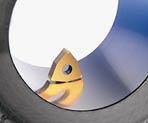I have witnessed a major change in the production machining business during my career. Every area of the fishbone chart—man, machines, methods, materials—has seen some major change, if not revolutionary developments. These are developments that require a major assessment of how we approach our work.
This article focuses on the impact of the changes in some of the materials that our industry is currently machining.
Where We Were
Years ago, production machining was about huge runs; half a million to a million pieces. This was a function of limited models in limited markets—automotive, appliance, plumbing—and a growing population in North America. Twenty-four hour setups on cam operated multi- spindle automatics were typical, and with a week or so of run time to make the required lot, setup costs were easy to recover. When making a half a million parts, cycle time and cheapest production per piece is the production philosophy. In the case of these large volumes of parts, commodity thinking is appropriate. Just like the farmer harvesting bushels of wheat, getting the lowest costs is key to extracting a profit when the price is defined by the market.
This commodity thinking, based on huge volumes, gave us a world where successful production machining was characterized by standardized operations “ground into the cam;” free cutting materials with high amounts of sulfur, often containing additions of phosphorous, lead, tellurium, selenium and bismuth; and a penchant to buy the cheapest shop tools to minimize cost.
A material example of these “good old days” is the grade Beth Led-B, which was melted to the 12L14 chemistry, but held the sulfur to 0.40 weight percent minimum. This was the secret to cutting yet another second off the cycle time for many Davenport shops, as the higher sulfur and some other aspects of the production process practically had the chips waiting to jump off the bar. The starting point for many “Led-B” jobs was 300 sfm. All that needed to be done was to lay the tool on it, or so it seemed. Machining in high volume production environments was based on machining friendly materials, fast cycle times, 300+ sfm and cheap or jobber quality tools because the materials were so forgiving. Free machining materials on our cam automatics were the key to a low piece price on the “bushels and bushels” of parts that often were shoveled into totes, drums or boxes.
Where We Are Today
Today, a production lot of more than 50,000 pieces is a rare bird; 5,000 pieces is often considered to be a nice run. Setups, even on cam automatics, are no longer affordable if they exceed 2 hours. With CNC machines in the hands of most shops and today’s smaller lot sizes, minimizing setup time is critical. Inability to set up in a time short enough so that the costs can be recovered despite the smaller production run is one major change that faces companies, but not shops. If the costs of the setups are too long (expensive) in our quote, shops will never even see the order.
The few growing markets we serve today—medical, aerospace, food equipment and others—are characterized by small lots, non-free machining materials and difficult to achieve requirements for the machinist—no burrs, great surface finish and extremely tight tolerances. The major difference that we see in shops is that the work materials machined are no longer designed for optimum machinability and lowest cost of production. The materials for today’s small lot size order are challenging and exotic—non-resulfurized plain carbon and alloy steels, non-free machining stainless steels, high nickel grades and titanium.
These exotic materials often work harden, may have high hardness or ductility or both, or exactly the opposite. The consistency from the good old days, because we bought large quantity mill runs from the same suppliers, is also gone. Today, production machinists are trying to figure out what to do when the exact same material, from two different suppliers, with virtually identical certifications for composition and properties, starts breaking or burning up tools. Here is how to rethink machining when faced with these new machining exotics.
Plain Carbon and Alloy Steels
The non-resulfurized plain carbon and alloy steels typically present production machinists with tool life issues or poor finish. The variability in tool life can be the result of factors in the steel or in the machining process. Steel factors can include variability in microstructure (especially if annealed by different suppliers), carburization or decarburization on the surface and inclusions or lack of inclusions within the steel. This is magnified when different original melt processes such as electric arc furnace (EAF) versus basic oxygen furnace (BOF) and different cold finishing practices throw added variability on mechanical properties and material makeup into a machine.
Using a consistent supplier to minimize upstream variability is an important strategy when machining these steels. Where specification and availability permit, insisting on minimum 0.02 percent by weight sulfur ensures that the chips will break. Tool failure can be diagnosed by looking at the tool’s failure mode.
Overheating is fixed by slowing down surface footage, increasing feed and possibly switching to harder or different coated carbide. Crater wear failures would call for harder carbide, reducing feed. Experimenting with coatings is always worthwhile when order quantities are small. Often the right coating will ensure that the entire job is run on a single tool, instead of downtime and frequent tool changes.
Poor finish in these steels is usually the result of built up edge issues. To improve surface finish on non-resulfurized, non-leaded plain carbon and alloy steels, a shop should try to increase speed, decrease feed and increase the nose radius. Better coatings and high quality metalworking fluids can also make a difference when the material doesn’t want to let the chip break. Expecting a lowest cost jobber quality tool to achieve the same results on low sulfur, non-annealed alloy steel as it does on 12L14 parts is unreasonable. Difficult materials will not run cost effectively with the cheapest tools.
Stainless Steels
Because stainless is a relatively poor conductor, heat management requires attention. Austenitic stainless steels make up the majority of non-free machining stainless steels that shops machine these days. 316/316L is a typical austenitic stainless that shops are seeing more frequently. Austenitics like this generally form a heavy, tough chip. They also develop higher feed loads and tend to work harden. This tendency to work harden is a frequent problem, so attention to tool replacement is far more important when cutting these steels. Another issue that shops fall prey to is using hardness as a guide for selecting speed on these grades. Hardness has not correlated well to cutting speed.
The precipitation hardening stainless steel grades behave much like the austenitics, except that their mechanical properties are even higher. Abrasive wear, thin chips and rapid edge wear are typical with these grades. Tool edge surveillance is critical to success on these. Light feeds, slower speeds and negative tool (side and rake) angles work on these. Rigid setups and stiff machines are critical to success. These grades are the opposite end of the spectrum than the free cutting grades that many shops machined when learning the craft.
Another thing to keep in mind on these grades is subsequent processing. A recent problem with a 17-4 PH part involved these parts cracking after machining, when their customer cold worked them. Two different material batches were involved, one cracking, the other not. A look at the mechanical properties told the tale. Even though both lots were certified to the same condition (-H900), the batch that crimped successfully had double the percent elongation of the batch that cracked.
The machining characteristics of martensitic stainless steels vary according to their carbon content. Their problems also correlate well to carbon. The low carbon martenistics tend to have chip buildup, which can seize on the tool. Higher carbon martensitics are abrasive. Hardness correlates to carbon content and is an indicator used in these grades: between 34-52 HRc machining is doable, with tool life decreasing
as hardness increases. Above 52 HRc, different approaches to machining will be required.
Nickel Based Alloys
These are among the most difficult materials machined on a production basis. They work harden, usually have a very ductile chip, are abrasive to tools, and their need for higher horsepower mandates rigid setups and stiff machines. Most shops do not understand that many of these grades require cutting speeds in the 40-70 sfm range.
To intelligently manage these materials on the shop floor, focusing on eliminating opportunities for work hardening is a good idea. Heavy feeds can cause work hardening, so lighter chip loads and slow speeds (70 sfm max., usually) will minimize work hardening below the surface of the cut.
Maintaining sharp tool edges is also important when avoiding work hardening, and keeping the surface footage constant regardless of diameter has helped on a couple of occasions. This propensity to work harden also dictates using a minimum nose radius, positive rake angles and plenty of clearance. No dwell is obvious, but must be mentioned. Because these grades develop a lot of heat when being cut, soluble coolants containing high pressure additives address both heat removal and built up edge on the tool. These materials generally require more than a horsepower per cubic inch of material removed per minute, so quoting conservatively is key.
Titanium
Shops are encountering titanium for both aerospace and medical applications, and the type of titanium makes a difference to the machinist. Commercially pure annealed titanium (183 Bhn) machines at about 300 sfm because of its relatively low strength. As strength and hardness increase in titanium grades, machinability tends to drop. Alpha-beta 6Al-4V typically has a hardness of 287-332 Bhn in annealed condition, to as much as 400-Bhn heat treated; running at half the sfm of the unalloyed grade would be considered a success.
The issues with titanium are its high strength combined with high ductility—the chip doesn’t want to separate—and titanium is a poor conductor. It is
characterized by rapid tool edge failure, which doesn’t look like abrasion, but is there, nonetheless. The chip might be reacting chemically with the tool material,
leading to tool edge breakdown. To attempt to manage these issues, the highest feed rate that is consistent with your equipment’s rigidity is the best place to start. Attention to tool edges is critical; tools should be changed at the first sign of edge wear or on a timed basis before they get to that point. Sometimes evidence of work hardening because of tool dwell will show up, which operators described as “hard spots” because there was a hard spot where they had let a dull tool rub on the material.
Titanium is an even poorer conductor of heat than stainless steel, so water-based soluble coolant/chemical coolants with high heat carrying capacity are the best choices for machining titanium.
Exotic Machining Requires
Different Thinking
The days of long setups, long runs of free cutting materials using cheapest tooling and shop supplies are nostalgic memories for most old timers. Today, we face smaller runs, the need for short setup times and workpiece materials that make us wonder, “How in the world are we supposed to machine this?” The answer in most cases is by using and paying careful attention to high quality tools, understanding the role of heat and not permitting work hardening in our process. If we do these things, we can get parts to print in the box at the end of the day. Slow surface footage and lighter feeds may mean longer cycle times, but these parts are priced more attractively than the parts we used to shovel into drums back in the old days. Looking at how the tool fails, paying attention to information on material certifications and having controlled processes in the shop for tool examination and replacement will help make the transition to profitably machining exotics.










.jpg;maxWidth=300;quality=90)






